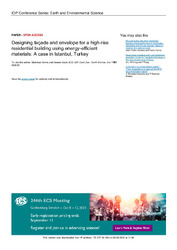Designing façade and envelope for a high-rise residential building using energy-efficient materials: A case in Istanbul, Turkey
| dc.contributor.author | Azima, Mahshad | |
| dc.contributor.author | Seyis, Senem | |
| dc.date.accessioned | 2023-08-08T10:42:02Z | |
| dc.date.available | 2023-08-08T10:42:02Z | |
| dc.date.issued | 2022 | |
| dc.identifier.issn | 1755-1307 | en_US |
| dc.identifier.uri | http://hdl.handle.net/10679/8589 | |
| dc.identifier.uri | https://iopscience.iop.org/article/10.1088/1755-1315/1101/2/022020 | |
| dc.description.abstract | The construction industry is responsible for 40% of global energy demand as buildings increase heating, cooling, and lighting demand. Therefore, building energy performance has become one of the most significant subjects for the architecture, engineering, and construction (AEC) industry in the last decade. The envelope of a building has an essential role in optimizing energy performance and consumption. The research objective of this study is to analyse and compare the impact of different envelope and facade materials on building energy performance for a high-rise residential building. The research methodology includes a literature review and a case study. The literature review analysed studies published between 2015 and 2021. In the literary review, 84 publications were extracted from Web of Science and Scopus databases, and the following sources were included: articles published in prominent journals, conference proceedings, thesis, scientific reports, and books. In the case study, passive strategies including building shape, orientation, insulation, window-wall ratio, and shelter were implemented in a 10-story residential building in Istanbul, Turkey. Design-Builder and EnergyPlus were used for analysing and comparing the energy performance of the different wall, insulation, and glass materials used in the building. Results demonstrate that each parameter and material has a considerable impact on the building energy performance. This study would contribute to the AEC literature and industry by comparing different envelope materials' energy performance and the proper scenario according to Turkey(Istanbul)'s climate. Policy-makers and decision-makers can benefit from the results of this research and amend the existing codes and policies for new high-rise buildings. | en_US |
| dc.language.iso | eng | en_US |
| dc.publisher | IOP Publishing | en_US |
| dc.relation.ispartof | IOP Conference Series: Earth and Environmental Science | |
| dc.rights | Attribution 3.0 Unported | |
| dc.rights | openAccess | |
| dc.rights.uri | https://creativecommons.org/licenses/by/3.0/ | |
| dc.title | Designing façade and envelope for a high-rise residential building using energy-efficient materials: A case in Istanbul, Turkey | en_US |
| dc.type | Conference paper | en_US |
| dc.publicationstatus | Published | en_US |
| dc.contributor.department | Özyeğin University | |
| dc.contributor.authorID | (ORCID 0000-0002-9133-9899 & YÖK ID 258625) Seyis, Senem | |
| dc.contributor.ozuauthor | Seyis, Senem | |
| dc.identifier.volume | 1101 | en_US |
| dc.identifier.issue | 2 | en_US |
| dc.identifier.doi | 10.1088/1755-1315/1101/2/022020 | en_US |
| dc.identifier.scopus | SCOPUS:2-s2.0-85144125550 | |
| dc.contributor.ozugradstudent | Azima, Mahshad | |
| dc.relation.publicationcategory | Conference Paper - International - Institutional Academic Staff and PhD Student |
Files in this item
This item appears in the following Collection(s)
Share this page




